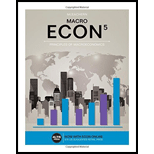
Sub-part
A
The role of the speed of adjustment of the nominal wage in the debate between the active and passive approaches
Sub-part
A
Explanation of Solution
Active
The main difference between the active and passive policy is due to the time lags for the enacting the policy. Therefore, the debate between the two types of the policies will come down to the speed at which the economic variable self-corrects and how long will it take for the agents to adjust their expectations. Therefore, the role that each of the following plays in the debate between active and passive policy is as follows:
The speed of adjustment of the nominal wage-faster adjustment of nominal wages means less need for active policy and greater time is available with the policymakers to make a corrective action, therefore, making case for passive policy.
Introduction:
Active Policy: It involves the decision of the central bank to deliberately act on the policy to change and alter the course of the economy through using fiscal and monetary measures
Passive Policy: It involves using policy to stabilize the economy and price levels using pre-defined by a set of rules, without changing the course of the economy
Nominal Wage: The wage-in hand that does not take into the change in the prices is known as the Nominal Wages
Inflation: The change in the overall prices of the economy, thereby reducing the overall
Sub-Part
B
The role of the speed of adjustment of expectations about inflation in the debate between the active and passive approaches
Sub-Part
B
Explanation of Solution
The speed of adjustment of expectations about the inflation-faster adjustment of inflation expectations means that the short-run
Introduction:
Active Policy: It involves the decision of the central bank to deliberately act on the policy to change and alter the course of the economy through using fiscal and monetary measures
Passive Policy: It involves using policy to stabilize the economy and price levels using pre-defined by a set of rules, without changing the course of the economy
Nominal Wage: The wage-in hand that does not take into the change in the prices is known as the Nominal Wages
Inflation: The change in the overall prices of the economy, thereby reducing the overall purchasing power of the citizens is known as Inflation
Unemployment: An economic condition wherein the number of jobs available in the economy is less than the people actively looking for the jobs
Sub-Part
C
The role of the existence of lags in policy creation and implementation in the debate between the active and passive approaches
Sub-Part
C
Explanation of Solution
Longer lags in policy creation and implementation: If there are long time lags for the policy-making and implementation, then by the time active policy would have acted, the other factors in the economy would have gone for self-correctness and adjustment of expectations would be done by the agents. Therefore, longer lags make active policy ineffective.
Introduction:
Active Policy: It involves the decision of the central bank to deliberately act on the policy to change and alter the course of the economy through using fiscal and monetary measures
Passive Policy: It involves using policy to stabilize the economy and price levels using pre-defined by a set of rules, without changing the course of the economy
Nominal Wage: The wage-in hand that does not take into the change in the prices is known as the Nominal Wages
Inflation: The change in the overall prices of the economy, thereby reducing the overall purchasing power of the citizens is known as Inflation
Unemployment: An economic condition wherein the number of jobs available in the economy is less than the people actively looking for the jobs
Sub-Part
D
The role of the variability in the natural rate of unemployment over time in the debate between the active and passive approaches
Sub-Part
D
Explanation of Solution
Variability in the natural rate of unemployment over time: If there is more variability in the natural rate of unemployment over time makes active policy ineffective as the changes made will not hold for longer duration of time, thus making passive policy an attractive option.
Introduction:
Active Policy: It involves the decision of the central bank to deliberately act on the policy to change and alter the course of the economy through using fiscal and monetary measures
Passive Policy: It involves using policy to stabilize the economy and price levels using pre-defined by a set of rules, without changing the course of the economy
Nominal Wage: The wage-in hand that does not take into the change in the prices is known as the Nominal Wages
Inflation: The change in the overall prices of the economy, thereby reducing the overall purchasing power of the citizens is known as Inflation
Unemployment: An economic condition wherein the number of jobs available in the economy is less than the people actively looking for the jobs
Want to see more full solutions like this?
Chapter 16 Solutions
Econ Macro (book Only)
- 1. We want to examine the comparative statics of the Black Scholes model. Complete the following table using the Excel model from class or another of your choice. Provide the call premium and the put premium for each scenario. Underlier Risk-free Scenario price rate Volatility Time to expiration Strike Call premium Put premium Baseline $50 5% 25% 1 year $55 Higher strike $50 5% 25% 1 year $60 Higher volatility $50 5% 40% 1 year $55 Higher risk free $50 8% 25% 1 year $55 More time $50 5% 25% 2 years $55 2. Look at the baseline scenario. a. What is the probability that the call is exercised in the baseline scenario? b. What is the probability that the put is exercised? c. Explain why the probabilities sum to 1.arrow_forwardSome people say that since inflation can be reduced in the long run without an increase in unemployment, we should reduce inflation to zero. Others believe that a steady rate of inflation at, say, 3 percent, should be our goal. What are the pros and cons of these two arguments? What, in your opinion, are good long-run goals for reducing inflation and unemployment?arrow_forwardExplain in words how investment multiplier and the interest sensitivity of aggregate demand affect the slope of the IS curve. Explain in words how and why the income and interest sensitivities of the demand for real balances affect the slope of the LM curve. According to the IS–LM model, what happens to the interest rate, income, consumption, and investment under the following circumstances?a. The central bank increases the money supply.b. The government increases government purchases.c. The government increases taxes.arrow_forward
- Suppose that a person’s wealth is $50,000 and that her yearlyincome is $60,000. Also suppose that her money demand functionis given by Md = $Y10.35 - i2Derive the demand for bonds. Suppose the interest rate increases by 10 percentage points. What is the effect on her demand for bonds?b. What are the effects of an increase in income on her demand for money and her demand for bonds? Explain in wordsarrow_forwardImagine you are a world leader and you just viewed this presentation as part of the United Nations Sustainable Development Goal Meeting. Summarize your findings https://www.youtube.com/watch?v=v7WUpgPZzpIarrow_forwardPlease draw a standard Commercial Bank Balance Sheet and briefly explain each of the main components.arrow_forward
- Please draw the Federal Reserve System’s Balance Sheet and briefly explain each of the main components.arrow_forward19. In a paragraph, no bullet, points please answer the question and follow the instructions. Give only the solution: Use the Feynman technique throughout. Assume that you’re explaining the answer to someone who doesn’t know the topic at all. How does the Federal Reserve currently get the federal funds rate where they want it to be?arrow_forward18. In a paragraph, no bullet, points please answer the question and follow the instructions. Give only the solution: Use the Feynman technique throughout. Assume that you’re explaining the answer to someone who doesn’t know the topic at all. Carefully compare and contrast fiscal policy and monetary policy.arrow_forward
- 15. In a paragraph, no bullet, points please answer the question and follow the instructions. Give only the solution: Use the Feynman technique throughout. Assume that you’re explaining the answer to someone who doesn’t know the topic at all. What are the common arguments for and against high levels of federal debt?arrow_forward17. In a paragraph, no bullet, points please answer the question and follow the instructions. Give only the solution: Use the Feynman technique throughout. Assume that you’re explaining the answer to someone who doesn’t know the topic at all. Explain the difference between present value and future value. Be sure to use and explain the mathematical formulas for both. How does one interpret these formulas?arrow_forward12. Give the solution: Use the Feynman technique throughout. Assume that you’re explaining the answer to someone who doesn’t know the topic at all. Show and carefully explain the Taylor rule and all of its components, used as a monetary policy guide.arrow_forward


 Principles of Economics 2eEconomicsISBN:9781947172364Author:Steven A. Greenlaw; David ShapiroPublisher:OpenStax
Principles of Economics 2eEconomicsISBN:9781947172364Author:Steven A. Greenlaw; David ShapiroPublisher:OpenStax

 Exploring EconomicsEconomicsISBN:9781544336329Author:Robert L. SextonPublisher:SAGE Publications, Inc
Exploring EconomicsEconomicsISBN:9781544336329Author:Robert L. SextonPublisher:SAGE Publications, Inc





